FireFly
- In the News:
- Firefly was featured in North West Tonight on 15th July.
If you missed it see it you can see it on BBC media player.
The Vision
The Firefly project envisions a world where every light source has an integrated computer, capable of self-organizing with its neighbours to form two and three dimensional ad hoc displays.
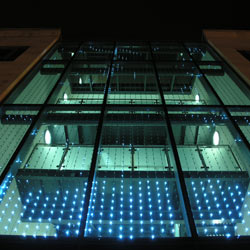
In essence, blurring the boundary between light and pixels.
More specifically, the project aims to develop:
- smart lighting devices capable of communication and self organizing behaviour
- scalability to enable the interoperation of thousands of such devices
- calibration of devices into coherent 2D/3D displays
- modeling and application development support
The goal of the project is to investigate the feasibility of this concept through applying autonomous computing concepts to display technology at a fundamental level.
We envision the spray on display surface as the ultimate vision for Firefly!
Applications
There are many potential application domains for this technology, ranging from:
- art installations in malls and hotels
- architectural and festive lighting
- ad hoc deployments in public
- places, such as stadiums
- interactive exhibits
- miniaturized ‘holographic’ displays
- smart environments
- ubiquitous computing
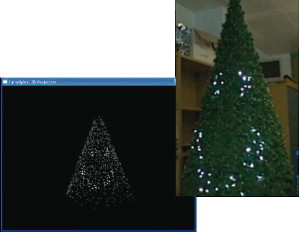
Moreover, this technology encourages incremental deployment - as more devices are deployed, the better the effect.
Finally, artists see this technology as a potentially new medium, with the ad-hoc deployment being key to public engagement.
We are currently active in evaluating large- scale deployments, and developing higher definition displays.
Technology
Lighting Elements. Every LED is integrated with a small microcontroller...
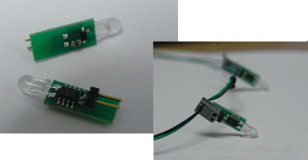 These devices are:
These devices are:
- 22mm x 9mm
- individually addressable
- self-addressing
- powered and controlled through a two conductor powerline network
- topology independent
- 30 frames per second update
- only four hardware components...
Control Elements. Interconnect networks of lighting elements to form larger displays.
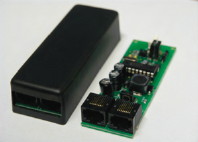 500kbps uplink
500kbps uplink - daisy chained
- form hierarchies to scale
- current sensed output
Ad-Hoc Deployment and Visual Calibration
Lighting elements can be deployed in any configuration to suit the environment... Either in the field, or at time of manufacture.
Location of lighting elements is determined through computer vision techniques.
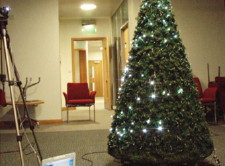
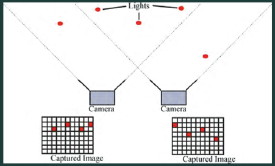
Each light beacons its address visually via a robust visual code. Digital cameras in the environment can then identify and locate the lights using similar techniques to those applied in CDMA networks, up to 250 lights can be calibrated simultaneously.
Multiple camera angles allow the localization of lighting elements in 3D space through triangulation and linear optimization techniques...
Modeling
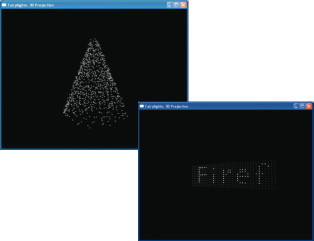
Once calibrated, a digital model of the deployment is formed, that represents the location of all the light sources.
The Firefly API then provides software support to enable easy development of applications targeted at these displays, via:
- a Microsoft .NET based API
- support for 2D planes, 3D wrapped surfaces and 3D dense deployments
- seamless integration to Firefly hardware
- primitives mapped into 3D space, that can be moved, animated and deployed on Firefly deployments in real-time
- 3D model slicing to form directed 2D faces real-time visualization and simulation
Events
- CityLab Alight! Lancaster City Centre, December 2007 and onwards
-
Three thousand lights create a stunning display for Christmas shoppers in Lancaster Ciy Centre. Rising three stories the 7m by 5m window at the for of CityLab in Dalton Square Lancaster is filled with light. Strings of FireFly units hang in fluid cascades making the largest display yet. The statue of Queen Victoria stands in the middle of Dalton Square ... what would she have said?
See them yourself! – The City Lab lights remain in place, so if you are in Lancaster make sure you stop by ... just ask for Queen Victoria and you can't miss them. (maps: multimap, google)
- Technology Matters InfoLab21, December 2006 and January 2007
- Firefly launched at Knowledge Business Centre as part of one of the KBC regular Technology Matters series of breakfast events. Intense interest in the technology led to a dedicated breakfast event the following month..
- Setpoint Science and Technology Day InfoLab21, September 2007
- School children visit InfoLab and see Firefly in action. The SETPOINT event was targeted at girls from ethnic minorities in the Lancashire area.
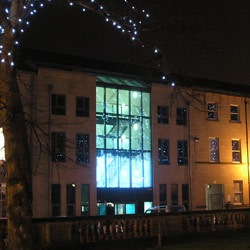
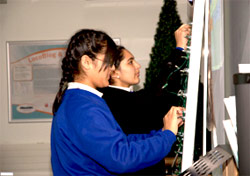
Contacts
Prof. Alan Dix, Dr. Joe Finney, Dr. Angie Chandler
Computing Department, InfoLab21,
Lancaster University
Funded by HEFCE SRIF and Lancaster University Business Enterprise Centre and Knowledge Business Centre
 |
 |